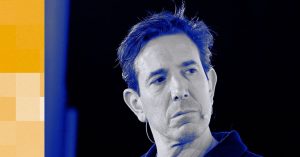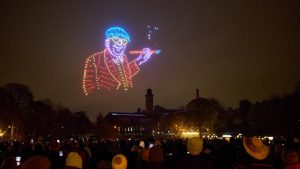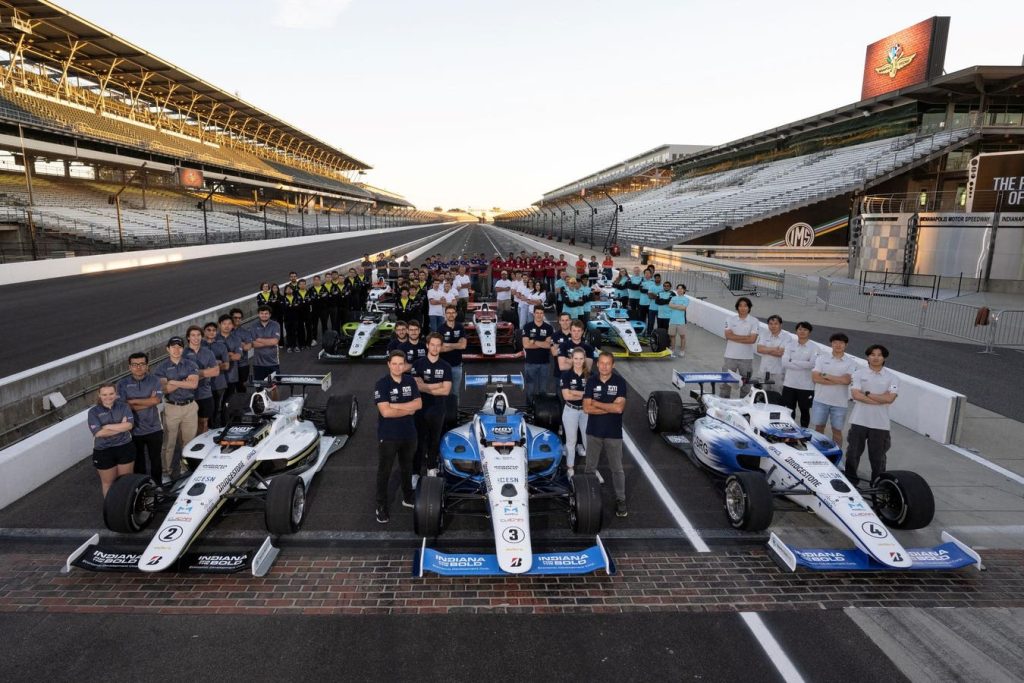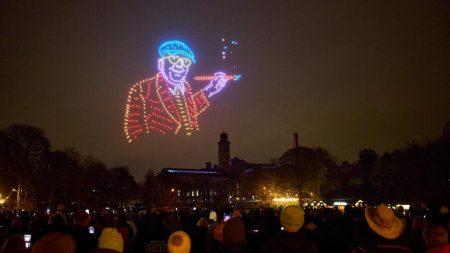Held at the historic site of the Indianapolis Motor Speedway, the Indy Autonomous Challenge (IAC) featured a fusion of speed, robotics, and artificial intelligence as well as an abundance of human emotions: passion, excitement, exhilaration, and in some cases disappointment. Nine world renowned university teams from Italy, Germany, South Korea and the United States competed to achieve the title of the world’s fastest autonomous car on September 6, 2024.
The IAC started 3 years ago on the historic Indianapolis Motor Speedway, commissioned in 1909 and host of the famous Indy 500 race held in May every year. The stadium has a capacity of 350,00 and is arguably a mini city within Indianapolis. According to Paul Mitchell, the CEO and president of the IAC, the founding of this event was motivated by a goal to put the State of Indiana on the map for autonomous mobility. Indiana’s legacy of leadership in motor sport events made an autonomous racecar event a natural choice. The goal is to bring cutting edge robotics technology and mobility advances to the masses and generate enthusiasm for STEM education, scholarship and entrepreneurship in Indiana and beyond. Demonstrating in real life how technology plays a role in replacing a very rare breed – human racecar drivers – makes it challenging, entertaining and exciting. A variety of industrial sponsors provide the hardware (mechanics, ICE engines, steering, brakes, sensors, tires, compute engines, etc.) for the racecars – which are identically built by IAC for each participant.
Mr. Mitchell highlights the 3 main goals of the IAC:
1) Building a pool of high caliber graduate student researchers who are stress tested, experience teamwork and solve real time problems in tense situations. Over its 3-year history, > 250 students have participated in the IAC with 150 in this event.
2) Live testing of the vehicle hardware and software in extreme edge cases of speed, vibration, heat, shock and obstacles provides invaluable information for academic research and product feedback for the industrial sponsors.
3) Generating interest in autonomous mobility and winning the hearts and minds of the community, government agencies, students, industrial sponsors and entrepreneurs.
The creation of the IAC was inspired by DARPA and the Grand Challenges they sponsored two decades ago. It launched the modern autonomous vehicle industry globally, with multi-billion dollar investments. DARPA participated in the IAC’s recent AI and Automation Summit, held the morning before the race, where they discussed the launch of a new program on physical AI and the transfer of autonomy from simulation to real environments. IAC will be a key partner of DARPA in this new program.
Race Rules
For the Speed competition, each team has 7 minutes of timed laps with the average speed of their fastest lap determining their place. There can be no human interaction with the racecars during the runs. The only communication is from IAC race control which sends electronic flags letting the “driver” know its timed laps have started (green flag), slowing it down if there is a caution (yellow flag), and signaling when it is time to come back to the pits (black flag).
The Passing competition is a head-to-head race that involves two racecars on the track at the same time. The two racecars trade attacker and defender positions and must complete a pass within one full lap at increasing speed levels or rounds. The first round is 80 mph and the speed increase in 10 or 5 mile per hour increments. If a team fails to complete a pass in one lap or has an accident, they lose. The qualified teams are organized in a bracket system with quarterfinals, semifinals, and finales with the results of the time trial competition determining the seeding.
The Racecars
The racecars that are used are named IAC AV-24. They are the same Dallara build chassis used in the IndyNXT Championship Series which is then modified by IAC to install the robotics hardware and compute stack. The university teams load their unique AI driver software into the central computer provided by dSPACE GmbH (part of the AV-24 robotics system in the cockpit). The IAC AV-24 is the fastest autonomous vehicle in the world setting a land speed record of 192.2 mph set in April 2022 at the Kennedy Space Center using the AI driver from team PoliMOVE and University of Alabama. Figure 1 provides more details of the hardware:
The Competing Teams
A total of 9 teams qualified (based on earlier speed trials) for the final competition:
- Cavalier Autonomous Racing (University of Virginia)
- PoliMOVE-MSU (Collaboration between Politecnico di Milano, Italy, Michigan State University and University of Alabama)
- TUM Autonomous Motorsport (Technische Universität München, Germany)
- KAIST (Korea Advanced Institute of Science and Technology)
- Unimore Racing (University of Modena and Reggio Emilia, Italy)
- Autonomous Tiger Racing (Auburn University)
- Purdue AI Racing (Purdue University)
- AI Racing Tech (Universities of California at Berkeley and San Diego, Hawaii and Carnegie Mellon)
- IU LUDDY (Indiana University)
The Caltech team, a new addition to the competition, was present at the track and will participate in the 2025 CES (Consumer Electronics Show) event.
The Strategy
Since all cars are identical in hardware, the challenge is to develop software that can perceive the environment, accurately simulate vehicle-road dynamics, localize the car position, plan path trajectory and vehicle speed, and execute appropriate control actions – all at speeds approaching 150-1885 mph. It requires a combination of physical world understanding and integration with intelligent software to achieve speed and other race metrics.
The amount of sensor data generated per second is staggering – the trick is to constantly assess what is important and make split second control decisions. For the passing competition, assessing the other vehicle and its tactics to pass or maintain the lead is also critical. Adjusting to changing weather, track surface and wind resistance is also important. Each team has spent the past 12 months working on the physical simulations and software, with the past two weeks spent on test driving, collecting the data and fine tuning their software and race strategy.
The Speed Competition
With an oval test track spanning 2.5 miles, and speeds in the range of 150 mph, an average lap takes about 1 minute. With a time limit of 7 minutes for the speed competition, a team can expect to go through about 7 laps. The initial laps are “slow” – in the range of 130 -145 mph, the reason being that the tires need to warm up for optimal tire-road surface traction. The later laps are increasingly faster in the range of 160 -185 mph.
Each team entered the speed competition and tried to achieve the maximum average speed/lap, typically in the 5th or 6th lap. A thunderstorm and rain caused a brief delay after the first 3 teams completed their laps. A set of service cars set out to dry the track before the competition could restart.
TUM was the first team to go after the rain delay, and performed well in the first 5 laps, achieving an average lap speed of 166 mph. During the 6th lap, as the car tried to best this record, it lost control on the sharp turn on the oval and crashed. This caused a delay for clean-up and debris removal (interestingly, a Tesla Cybertruck was one of the service vehicles that assisted, see Figure 10. An EV in the midst of ICE cars!). Unfortunately, for TUM, the competition was over, and the emotional downer for the team was heartbreaking.
The Cavalier team (University of Virginia) won first place, making it the first time that a U.S. team has won this award. During the final lap, they reached a maximum speed of 184 mph, which is a world record for the IAC competition. According to Dr. Madhur Behl, an Associate Professor of Computer Science and the project lead: “This competition is fundamentally a “battle of algorithms.” All the cars are nearly identical in hardware-sensors, chassis, engine, onboard computer. Winning comes down to building a superior AI driver that can push the boundaries of perception, planning, and control, operating right at the edge of what’s possible. Latency is a critical issue and requires innovation and system designs that are fast, robust and predictive”.
The Passing Competition
Six teams participated, based on previously meeting qualifications during trials and then seeded by the results of the speed competition.
Although TUM would have been one of the competitors, the crash during the speed competition made the vehicle unusable. As a result, 5 teams competed. The weather had gotten cooler and strong wind gusts started (24 mph).
AI Racing Tech and Unimore went first, with the latter attacking (behind). During the third lap after exiting the sharp turn on the oval track, Unimore was able to overtake AI Racing Tech, at a speed of 120 mph. AI Racing Tech tried to pass in the fourth lap, but a breakdown occurred, possibly due to loss of GPS signal (faulty wire?), causing a loss of localization. Unimore was declared the winner.
After the clean-up and towing of the AI Racing Tech car, PolyMove-MSU went next against KAIST. Polymove-MSU as the attacker vehicle passed KAIST in the second lap. After this, KAIST seemed to slow down, inexplicably. They never really tried to regain the lead, possibly because the software just did not have the confidence to power ahead.
It was Cavalier Racing and Unimore next, and this was an intense competition, with each team passing the other multiple times. The unexpected happened. A bird (yes, a bird!) hit the Cavalier car camera which was moving at 120 mph and in the lead, throwing debris on the track (Tesla CyberTruck to the rescue again). This caused the vehicle to stop, handing Unimore the victory.
Excitement and emotions ran high as the all-Italian final between PoliMOVE-MSU and Unimore commenced. The competition was intense with multiple passes by each team, and increasing speeds of up to 170 mph. During the sixth lap, PoliMOVE-MSU took the lead, and Unimore could not pass. PoliMOVE-MSU was declared the winner.
An event where robotic racecars compete on a closed racetrack seems boring. But as this IAC event demonstrated, this is far from the case. From the 150 people competing on the 9 teams to the 1500 high school STEM and other spectators, the human element was intense. Unfortunately, 3 cars were damaged and a bird probably injured. From excitement and exhilaration, to surprises and disappointments, human drama was on display for the roughly 6 hours of the competition. Interestingly, there were no screaming matches between teammates. The camaraderie between competing teams was inspiring – during victory, defeat and accidents.
The impact of the competition on developing a talent pool for autonomy, exciting young STEM students to enter the field, engaging government entities and spectators to celebrate the event was spectacular. A perfect fusion of great hardware, cold blooded AI and warm blooded human emotions.
The lessons learned from the race in terms of developing agile and adaptive autonomous systems have significant implications for terrestrial transportation (Tesla FSD anyone !), as well as other domains like outer space, underwater and aerospace environment.
Read the full article here








